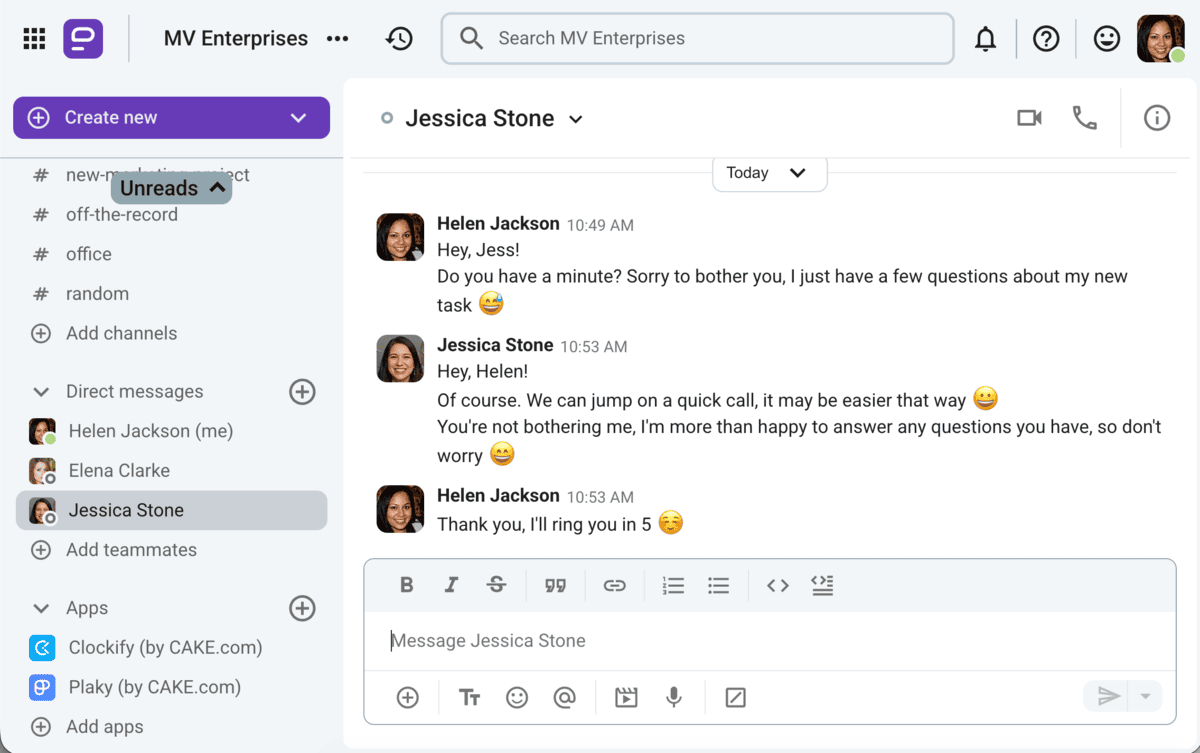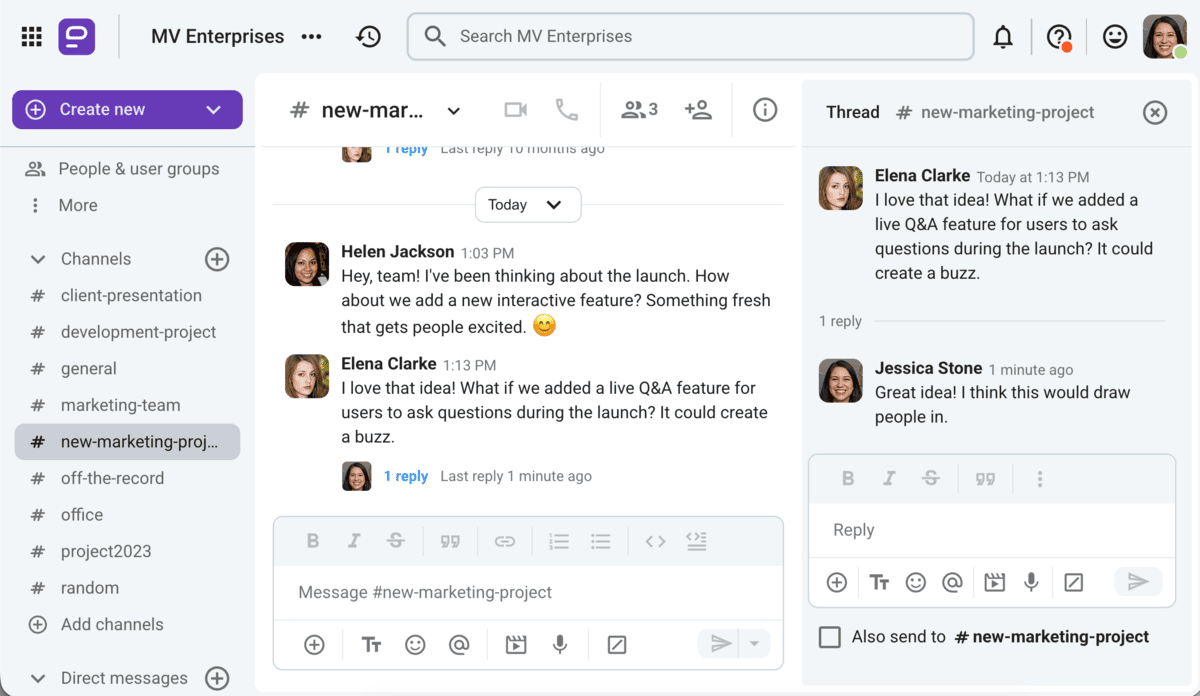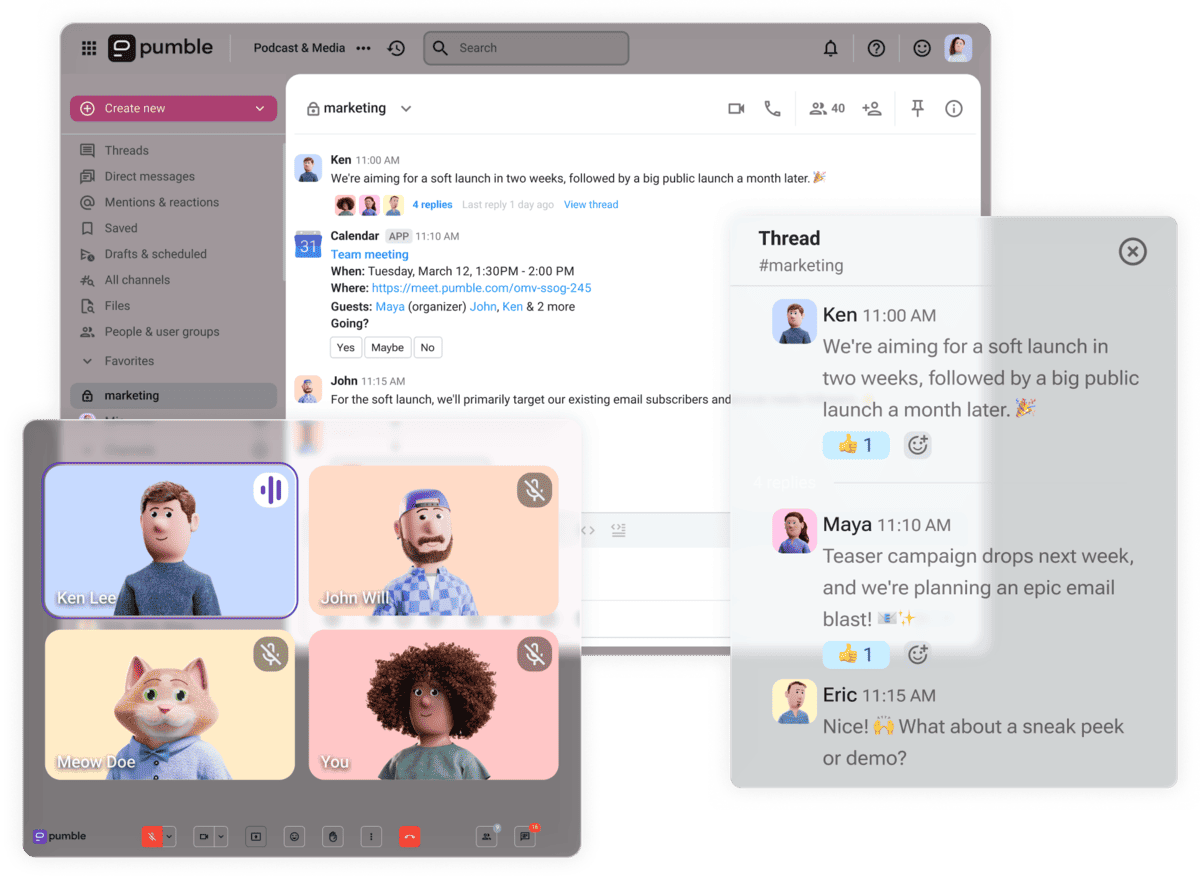Communication in the workplace can make or break your company.
Too often, communication is brushed off as a soft skill — something nice to have but not essential. In reality, communication is the central nervous system of any organization. The way people share ideas, give feedback, and resolve conflicts determines whether a team thrives or stalls.
Positive communication that is clear, respectful, and empathetic, fuels trust, morale, and productivity.
On the other hand, negative communication drains energy, creates silos, and pushes good employees out the door.
The quality of communication doesn’t just shape workplace culture, it directly predicts whether a business succeeds or struggles. That’s why building positive communication habits isn’t optional — it’s one of the most important investments any business can make.
To learn about the differences between positive and negative communication in the workplace and how you can implement positive communication in your team, keep on reading.

Table of Contents
What is negative communication?
Negative communication in the workplace doesn’t always manifest as shouting or overt hostility.
More often, it shows up as avoidance, misalignment, or subtle undermining behaviors.
While these behaviors may seem small in isolation, their cumulative impact:
- Erodes trust,
- Breaks down communication,
- Creates unhealthy work environments, and
- Eats away at productivity.
Let’s see what exactly negative communication is.
What makes communication negative?
Negative communication is communication that:
- Reduces clarity,
- Increases stress, and/or
- Damages relationships.
It comes in different forms, but its impact is always destructive.
The 3 most common styles of negative communication are:
- Passive communication — Individuals fail to express their opinions, protect their rights, and identify their needs. In the workplace, this looks like employees staying silent during meetings, not speaking up when something bothers them, and nodding along to decisions they don’t agree with.
A passive communicator may say: “It’s fine, don’t worry about it,” even when a problem is festering. Over time, this silence leads to missed opportunities, unresolved issues, and frustration that eventually surfaces as resentment or burnout.
- Aggressive communication — Individuals advocate for their needs and wants in a way that violates the needs and wants of others. Aggressive communication may be loud and obvious — like a manager berating a team member in a meeting — or subtle, such as interrupting, dismissing others’ ideas, or using intimidating body language.
Aggressive communication may get short-term compliance, but it destroys long-term trust and alienates and hurts others.
- Passive-aggressive communication — The most insidious form of negative communication, passive-aggression, includes sarcasm, backhanded compliments, avoiding conflicts, or failing to use direct communication. This can look like sarcasm in conversations, “forgetting” to include coworkers in important threads, or agreeing in a meeting but undermining decisions afterward.
This style of communication breeds resentment and confusion. Team members may start second-guessing intentions, instead of focusing on the solutions.
Here’s what negative communication can look like in practice:

Here are a few more examples of how negative communication can sound in real situations, along with some better alternatives, using positive communication:
| Style of communication | Negative example | Better alternative |
|---|---|---|
| Passive communication | A team member notices a serious error on a report but stays silent: “It’s probably fine, I don’t want to cause a scene.” | “I noticed a discrepancy in the numbers, I think we should review it once more.” (assertive and constructive) |
| Aggressive communication | A manager slams the table in frustration: “Why can’t you ever get this right?” | “I see this wasn’t done correctly. Let’s redo it and walk through what went wrong to avoid this next time.” (clear and respectful) |
| Passive-aggressive communication | An employee says: “Sure, I’ll do it… like I always do.” with a sarcastic tone and an eyeroll. | “I’ve noticed I’m often assigned this task. Could we rotate responsibilities to keep tasks balanced?” (assertive and clear) |
💡 Pumble Pro Tip
For a more detailed look into different communication styles, including passive, aggressive, and passive-aggressive communication, check out our guide:
Negative non-verbal cues
Communication isn’t just about words — it’s also about non-verbal cues.
Body language can either reinforce trust and understanding or undermine it entirely.
Negative body language often sends signals of disinterest, hostility, or avoidance, even when words seem polite. In the workplace, this creates confusion, lowers team morale, and deepens conflict.
Here are some examples of non-verbal cues you should be aware of:
- Crossed arms — shows defensiveness or discomfort,
- Avoiding eye contact — shows nervousness, dishonesty, low self-esteem, or lack of confidence,
- Poor posture — shows a lack of confidence, interest, and/or ability,
- Aggressive posture — leaning too close or pointing fingers can feel intimidating and disrespectful,
- Eye rolling or sighing — signs of disrespect and boredom,
- Covering your mouth — shows a lack of confidence, and
- Rapid finger tapping and fidgeting — shows nervousness, lack of focus, and/or boredom.
Even if words are neutral or positive, these non-verbal cues often leave a negative impression, reducing trust and creating a hostile environment.
Effects of negative communication in the workplace
The damage that negative communication causes isn’t just limited to strained conversations — it shows up in measurable outcomes, hurting employee productivity, increasing stress, destroying trust, and leading to high employee turnover.
Let’s take a closer look at some effects of negative communication in the workplace.
Negative communication decreases productivity
Negative communication results in lower productivity.
There are several possible causes:
- Unclear expectations — you’re not sure what you have to do, as no one told you.
- Inability to ask questions — your questions are dismissed or met with defensiveness .
- Withheld information — no one shares important information with you.
- Stressful environment — the atmosphere in the workplace is negative and everyone is competing with each other.
Unclear expectations are one of the key factors, with only 46% of employees being sure what is expected of them at work.
Instead of being engaged and productive, employees spend more time clarifying unclear instructions, fixing avoidable mistakes, or managing interpersonal conflicts. In these conditions, doing your best is next to impossible.
So, unclear or hostile workplace communication isn’t just frustrating — it diverts focus away from meaningful work and stalls progress across the organization.
Communicate expectations clearly with Pumble
Negative communication increases stress and burnout
One of the most damaging effects of negative workplace communication is the way it increases stress and accelerates burnout.
Employees who face constant criticism, unclear expectations, or mixed messages can feel emotionally drained. Over time, this stress compounds.
In fact, according to statistics, 51% of employees report that poor communication has increased their overall stress levels.
When team members are unsure of what’s expected or feel they can’t safely voice concerns, they internalize stress and anxiety, which not only affects mental health, but also physical well-being. This creates a ripple effect of fatigue, disengagement, and ultimately leads to burnout.
As a result of communication issues, 43% of people have suffered from burnout, stress, and fatigue.
Eventually, the outcome is employees who are present in body but checked out in mind, operating well below their full potential.
💡 Pumble Pro Tip
Burnout doesn’t happen overnight — it has 12 distinct stages. To learn more about burnout and how to recover from it, these tips can help you:
Negative communication leads to loss of trust in leadership
Trust is the foundation of any strong workplace culture, and negative communication erodes it quickly.
When leaders communicate in a dismissive, aggressive, or passive manner, employees stop believing their voices matter.
Over time, this lack of psychological safety discourages employees from sharing feedback, asking for help, or taking creative risks.
Transparency also suffers — employees wonder what’s being hidden from them or why certain conversations happen behind closed doors.
Low trust also hurts day-to-day effort and productivity, as 68% of employees report.
Once trust and transparency break down, team morale collapses, and collaboration becomes superficial at best.
Rebuilding trust after it’s been lost requires more time and energy than maintaining it with positive communication from the start.
💡 Pumble Pro Tip
Trust takes a long time to establish, but it doesn’t take long to lose it. If you want to learn more about how you can build trust in your remote teams, check out our post:
Negative communication results in high employee turnover
The costliest consequence of negative communication is employee turnover.
When workers feel undervalued, constantly criticized, or left in the dark, they eventually look for better opportunities elsewhere.
Toxic communication habits create an environment where employees don’t just dislike their jobs — they actively plan to leave.
The Work Institute estimates that employee turnover cost almost a trillion dollars in the last year in the U.S. alone.
Beyond financial losses, turnover:
- Disrupts teams,
- Creates knowledge gaps, and
- Lowers team morale for those left behind.
New hires can’t simply replace the relationships, organizational knowledge, and cultural stability that is lost when employees walk out the door.
Negative communication doesn’t just push individuals away – it destabilizes entire organizations.
💡 Pumble Pro Tip
If you’re experiencing high employee turnover in your organization, check out our guide on best practices for employee retention:
What is positive communication?
While negative communication drains energy, positive communication fuels it.
Positive communication in the workplace creates clarity, strengthens trust, and encourages employees to be empathetic and respectful, even in difficult conversations.
However, positive communication isn’t about sugarcoating or being endlessly agreeable.
Instead, it’s about communicating in ways that are assertive, respectful and constructive.
What makes communication positive
Positive communication is intentional and it emphasizes clarity, collaboration, and respect. These 3 core styles of communication define positive communication:
- Assertive communication — An assertive communicator speaks up clearly and respectfully, setting boundaries without hostility. By being assertive, you can freely express your needs and opinions without dismissing or silencing others.
For example, a manager can say “We need to adjust the timeline to maintain quality,” instead of avoiding the issue (passive) or demanding change with no explanation (aggressive).
- Clear communication — Clarity prevents misunderstandings. Instead of vague and unclear communication, you need to adopt a direct and transparent communication style that clearly defines expectations and responsibilities.
For instance, instead of saying “Get this done soon,” a clear communicator says, “Please send me the final version by Friday at 3 p.m.”
- Empathetic communication — Empathetic communication is all about understanding the perspective, emotions, and challenges of others. An empathetic communicator listens actively, validates feelings, and frames thoughtful responses.
For example, rather than telling a stressed employee “We’re all busy, just deal with it,” an empathetic leader might say “This project has been intense, let’s review how we can adjust the workload.”

The following table shows examples of positive communication styles, contrasted with less effective and negative approaches:
| Communication style | Positive example | Negative alternative |
|---|---|---|
| Assertive communication | “I understand this deadline is tight. To deliver quality results, we need to extend by 2 days or add another team member.” | “This deadline is impossible. I don’t care what leadership says.” (aggressive) or“Sure, we’ll try to make it in time,” while knowing it can’t be done. (passive) |
| Clear communication | “The client presentation needs 3 slides: overview, results, and next steps. Please send it by Thursday at noon.” | “Just make it look good and get it done fast.” (unclear) |
| Empathetic communication | “I know this last week has been demanding. How are you holding up and can I help you in any way?” | “We’re all under pressure, you just have to push through.” (unhelpful and cold) |
Uphold positive team communication with Pumble
💡 Pumble Pro Tip
Another important skill to have to be a positive communicator is active communication. To learn more about active communication and the difference between passive and active communication, read our post:
The 7 Cs of positive and effective communication
Additionally, positive and effective communication consists of 7 Cs:
- Clarity — You can easily define the main message.
- Conciseness — You’re not rambling and going into unnecessary detail. You keep it short and straight to the point.
- Concreteness — You provide examples and facts, so your audience has no trouble understanding your point.
- Correctness — There are no errors and you present your message in a way that fits your audience.
- Coherence — Your points logically connect to one another.
- Completeness — You include all relevant information.
- Courtesy — You communicate politely, friendly, and professionally.
If you master these communication skills, you’ll probably become someone everyone likes working with.
However, positive communication is more than just what you say.
Positive non-verbal cues
Just as negative non-verbal cues create distance, positive body language builds connection and trust.
It reinforces your verbal communication, showing that you are engaged, empathetic, and approachable.
Positive non-verbal cues are especially important in high-stakes environments like important meetings, feedback sessions, or conflict-resolution discussions.
Here are some examples of positive body language:
- Maintaining eye contact — demonstrates confidence and attentiveness,
- Open posture with uncrossed arms and leaning slightly forward — signals openness, receptiveness, and interest,
- Nodding occasionally — reinforces active listening and validates other people’s input,
- Smiling — encourages bonding and honesty through psychological safety,
- A firm handshake — shows interest and enthusiasm, and
- Calm and steady tone — a calm tone paired with relaxed gestures reinforces a positive experience for both parties.
Positive non-verbal cues complement assertive, empathetic communication, and make people feel valued, understood, and safe.
Effects and importance of positive communication in the workplace
Whereas negative communication drains energy and damages culture, positive communication creates the opposite effect — it drives engagement, builds trust, and empowers employees to thrive.
But, its impact isn’t limited to warm feelings and good vibes. The importance of positive communication is also evident in measurable improvements in productivity, retention, and innovation.
Here are some of the most important effects of positive communication in the workplace.
Positive communication increases productivity
Positive communication directly boosts productivity by reducing wasted time, rework, and misunderstandings.
When employees know exactly what’s expected of them and feel safe to ask clarifying questions, projects can move forward without unnecessary delays.
In fact, the aforementioned studies shows that 64% of leaders believe that effective communication has increased their team’s productivity, and 55% of knowledge workers agree.
Teams that practice assertive and clear communication avoid bottlenecks and duplication of effort, ensuring everyone directs their energy towards meaningful results.
In short, positive communication increases productivity by enabling:
- Smoother workflows,
- Faster results, and
- Better performance.
Communicate effectively and increase productivity with Pumble
Positive communication leads to higher employee engagement
Employee engagement is built on trust, respect and a sense of belonging — all of which stem from positive communication.
When leaders listen, acknowledge contributions, and encourage open two-way communication, employees feel that their work matters. This positive approach to interpersonal communication translates into higher engagement and motivation and stronger performance.
However, global employee engagement fell last year, resulting in $438 billion in lost productivity.
That’s why investing in employee engagement should be at the forefront of any organization.
Engaged employees don’t just show up at work — they dedicate more effort, go the extra mile for their teams, and take pride in their work.
Maintain high employee engagement with Pumble
💡 Pumble Pro Tip
For more interesting statistics on employee engagement, check out our comprehensive guide:
Positive communication results in better employee retention
Retention is one of the clearest benefits of positive communication and biggest indicators of a healthy work environment.
Employees stay where they feel valued, respected and supported.
You can achieve this by building psychological safety in the workplace, which is mostly driven by a positive team climate.
With the help of positive and ethical communication, employees can raise concerns without fear of backlash and receive constructive feedback instead of criticism.
By contrast, toxic or unclear communication fuels disengagement and high turnover.
Retaining talent isn’t just about saving money on hiring — it’s about preserving knowledge, maintaining continuity, and attracting even more top performers.
Positive communication encourages innovation and creativity
Innovation thrives on open and positive communication, which encourages employees to share ideas, ask questions, and challenge assumptions without fear of judgment or ridicule.
Empathy and respect create an environment where diverse perspectives are welcomed, which fuels creativity.
When employees trust that their voices are heard, they are more likely to bring forward bold ideas, suggest improvements, and think outside the box.
Here’s an example of how positive team culture and communication can inspire new ideas:

Positive communication is the catalyst that allows innovation and creativity to flourish.
Encourage innovation with effortless communication in Pumble
Positive communication leads to better conflict resolution
Conflict is inevitable in any workplace, but the way it’s handled determines whether it damages or strengthens a team.
Over the last year in the UK alone, one quarter of employees have experienced some sort of a workplace conflict.
Positive communication, with a focus on problem solving, transforms conflict resolution from a destructive battle into a constructive process.
When employees, with support from a positive workplace culture, communicate assertively and empathetically, they can address issues directly without hostility.
Instead of letting frustrations fester, positive communicators:
- Listen,
- Validate emotions, and
- Search for solutions that work for everyone.
This approach resolves immediate disputes, but also strengthens trust and boosts employee morale over time.
Companies with positive communication practices are better equipped to handle communication challenges quickly and fairly — preventing small disagreements from escalating into major disruptions.
Resolve conflicts in private with Pumble
5 Actionable strategies to cultivate positive communication
Contrary to popular belief and myths, communication isn’t an innate skill — it’s something you learn and continuously work on.
So, if you recognized your team in the part about negative communication, don’t worry, not everything is lost — here are some tips and communication principles to help you increase positive and decrease negative workplace communication.
#1 Practice active listening
Active listening goes beyond hearing what the other person is saying — it’s about showing that you value the person speaking.
Being an active listener includes:
- Maintaining eye contact,
- Nodding as a sign of being present, and
- Asking follow up questions when appropriate.
Too often, people listen only to prepare their response, but true active listening focuses on understanding the other perspective first.
In the workplace, active listening helps:
- Prevent misunderstandings,
- Build trust, and
- Enable successful collaboration.
Teams that nurture and consistently practice active listening create healthier models of communication and become more effective in their collaboration.
#2 Give constructive feedback
Feedback can either build someone up or shut them down.
If you want to practice positive communication, constructive feedback is key — it’s direct and specific, but still focused on the solution.
Instead of vague criticism such as “This isn’t good enough”, constructive feedback may look like “The report is missing key data in the first section, let’s add that to strengthen it.”
This constructive approach addresses the issue without attacking the person.
When you frame feedback in a constructive way, your team members view it as an opportunity to improve, not as personal criticism.
Over time, this positive approach to feedback builds an overall positive team culture and encourages growth.
Provide employees with constructive feedback in Pumble
💡 Pumble Pro Tip
For more constructive ways to give feedback, as well as some more useful business communication phrases for different situations at work, check out our post:
#3 Set clear expectations of positive communication as a leader
Leaders shape team culture by defining what is and isn’t acceptable communication.
Setting clear expectations means making it known that positive communication — assertive, respectful, and empathetic — is the standard. You can’t overcommunicate these expectations — they are supposed to be repeated often.
Also, you need to let your team know that negative styles of communication like passive-aggressive remarks, dismissive comments, or open hostility have no place in your team.
These expectations should be explicitly stated, not assumed, and you need to lead by example.
For example, during employee onboarding or team meetings, leaders can outline that:
- Disagreements are normal but must be expressed calmly and respectfully,
- Feedback is encouraged but should always be focused on behaviors or outcomes, not personal attacks, and
- Aggressive behavior and words will not be tolerated in any case.
Additionally, everything you preach should be practiced. So, as a leader, you must model positive communication for your team.
Clear expectations of positive communication set the tone for building a positive team culture with respectful and accountable behavior.
Set a positive example as a leader in Pumble
#4 Reword your negatives into positives
How a message is framed makes all the difference.
Negative phrasing creates defensiveness, while positive framing encourages action.
For example, instead of “Sorry for being late”, try saying “Thank you for your patience.”
Focus on what can be done instead of what cannot, and on the good sides of the situation instead of the bad sides.
Here are some more examples of the differences between negative and positive language:
| Negative language | Positive language |
|---|---|
| “Can’t complain, I guess.” | “Everything is going well.” |
| “Not bad.” | “Good job.” |
| “We’re not used to being supervised.” | “We prefer working independently.” |
| “You can’t submit a request without that document.” | “I would be happy to approve your request, you just need to send me that document first.” |
| “Don’t submit incomplete reports.” | “Please ensure all reports contain A, B, and C.” |
| “Don’t interrupt me.” | “Let’s take turns speaking.” |
| “That presentation was boring.” | “Next time, you could add visuals or examples to make your presentations more engaging.” |
| “You didn’t explain this clearly enough in the report.” | “Could you expand this section of the report to make it easier for the reader to follow?” |
| “Don’t ignore emails.” | “Please check your emails regularly and respond in time.” |
The information in the examples is the same, but the tone is shifted from punitive to constructive. This simple change reduces conflicts and resistance and makes collaboration smoother.
#5 Choose the proper communication tools
Not every message belongs in an email, and not every discussion needs a meeting. Choosing the right communication channel saves time and ensures clarity, especially in remote work.
For example, urgent updates may warrant a voice call, while less essential messages can be sent as direct messages in a team communication app.
Leaders who choose communication tools wisely reduce miscommunication and information silos and accelerate communication.
Using the right tools in the right situations ensures messages are received, understood, and acted on in a timely manner.
The right environment for the right communication: How your tools shape your culture
Positive communication isn’t just about learning all the soft skills to enable it — it’s also about having the right tools to implement it.
Even the most talented and positive teams can’t thrive without reliable tools that support clarity, transparency and collaboration.
And, if we take into account that, according to the aforementioned Pumble statistics, 66% of knowledge workers and 72% of leaders wish they had better communication tools at work, it’s obvious that people need better solutions.
Pumble, a business communication platform, is designed to close that gap, giving teams a clear, structured space where positive communication can thrive.

Try Pumble today and experience clear communication
Pumble provides the structure and features that allow teams to put positive communication habits into practice every day.
Let’s see exactly how Pumble can help you transform your communication.
Fostering transparency with public channels
Lack of transparency is one of the fastest ways to damage trust at work.
When decisions are made in private or information is shared selectively, employees resort to filling in the blanks with speculation, often leading to confusion and resentment.
Pumble helps teams foster transparency with public channels — spaces where updates, decisions, and discussions can be shared openly.

Instead of having to rely on the grapevine effect, employees have direct access to the information they need, preventing knowledge gaps.
This openness helps put a stop to workplace miscommunication, but it also builds a transparent team culture, where employees feel included and heard.
Encouraging constructive feedback with threads
Feedback can be a powerful tool for growth, but only when it’s shared the right way.
In a crowded chat stream, or in an email with others included in the CC thread, feedback can feel like public criticism, even if that wasn’t the intention.
This can discourage employees from speaking up or make them defensive to your feedback.
Pumble addresses this with threaded conversations, allowing feedback to be heard, but not get overwhelming.

This structure keeps discussions relevant, contextual, and less personal.
Instead of feeling singled out in front of an audience, employees can view feedback as a collaborative effort to improve work.
Additionally, you can provide feedback to your team members in private direct messages.
Over time, this helps establish a culture where feedback is expected, welcome, and constructive.
Building a record of positive communication with unlimited message history
Workplace culture is shaped not only by daily interactions but also by the memories and records of those interactions.
When conversations get lost in endless chats or disappear after a set time, teams lose the chance to learn from past decisions or celebrate progress.
Pumble’s unlimited message history ensures that nothing meaningful gets lost.
Teams can create transparent and permanent archives in Pumble, where they can:
- Search for past feedback,
- Revisit decisions, and
- Look at how previous challenges were solved.
For new employees, this unlimited history acts as a window into team culture, showing how positive group communication happens in practice.
By keeping a permanent record of positive and constructive communication, organizations reinforce the behaviors that build trust and collaboration over the long term.
Make positive communication a habit with Pumble
Positive communication doesn’t exist in isolation — it needs the right environment to grow.
Even the most skilled communicator will struggle if their communication tools create silos, overwhelm them with clutter, or don’t support collaboration.
On the other hand, when your environment supports clarity, accessibility, and accountability, positive communication becomes easier and more consistent across the team.
If your organization is ready to strengthen trust, boost team morale, and improve productivity, try Pumble and see how it can help your team communicate better, every day.









